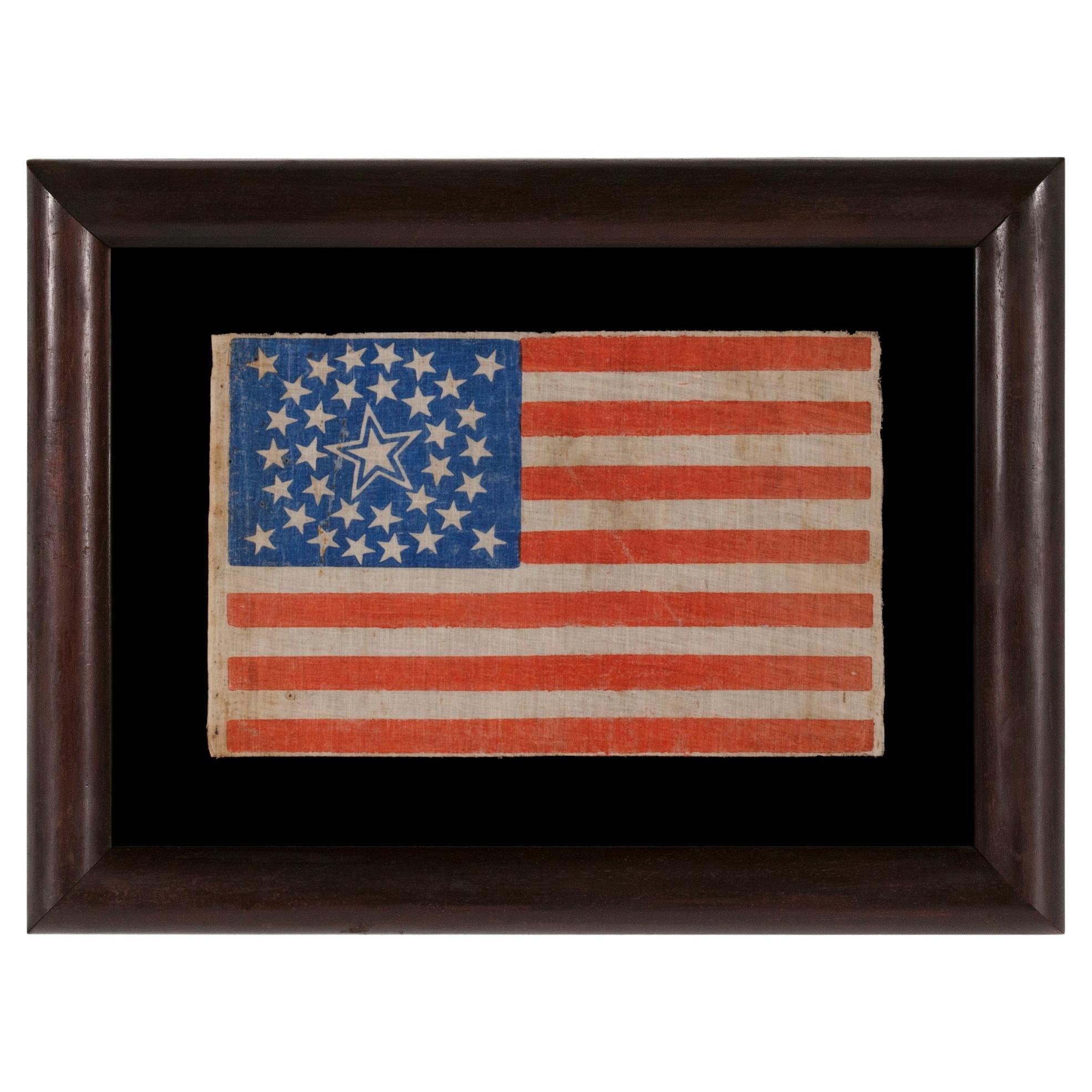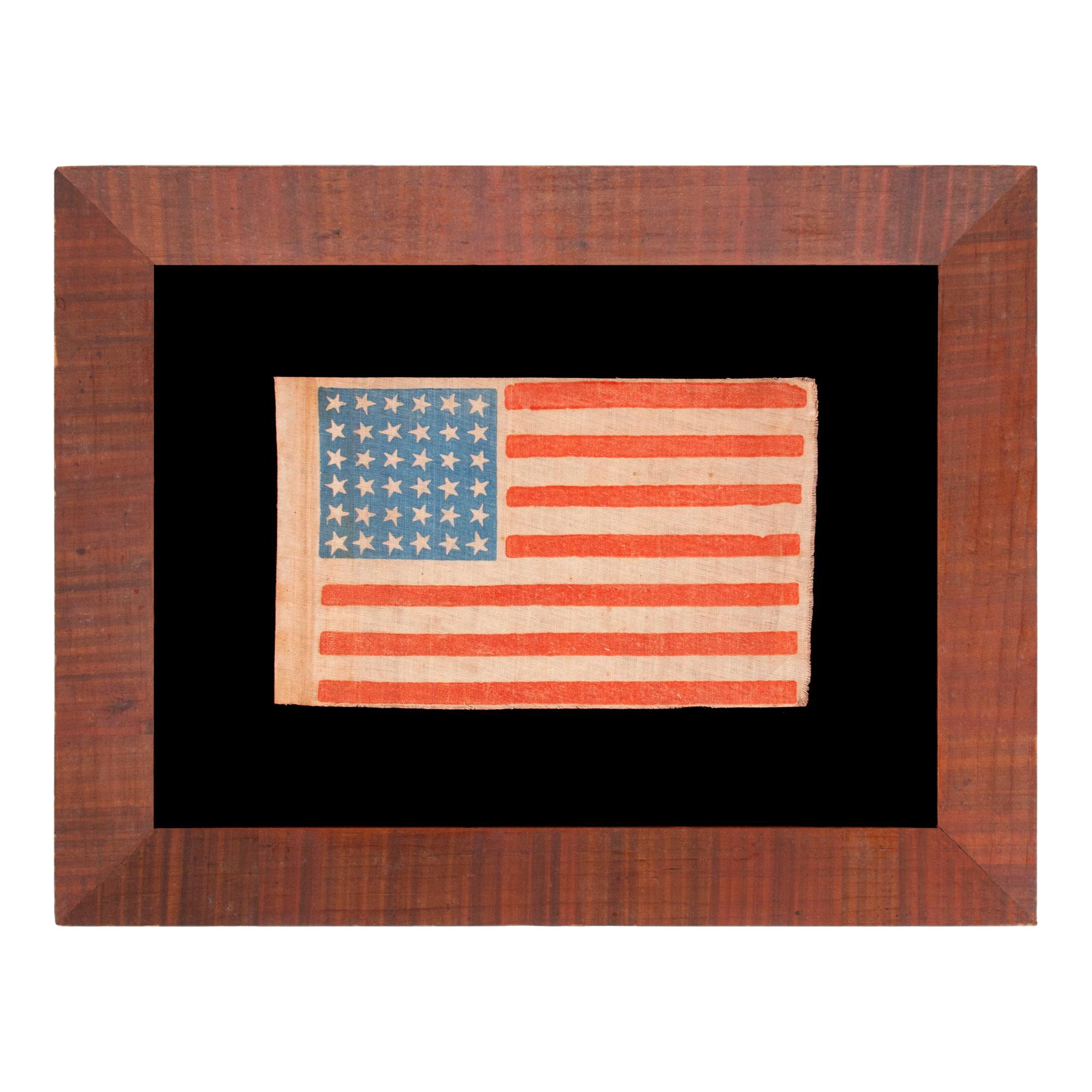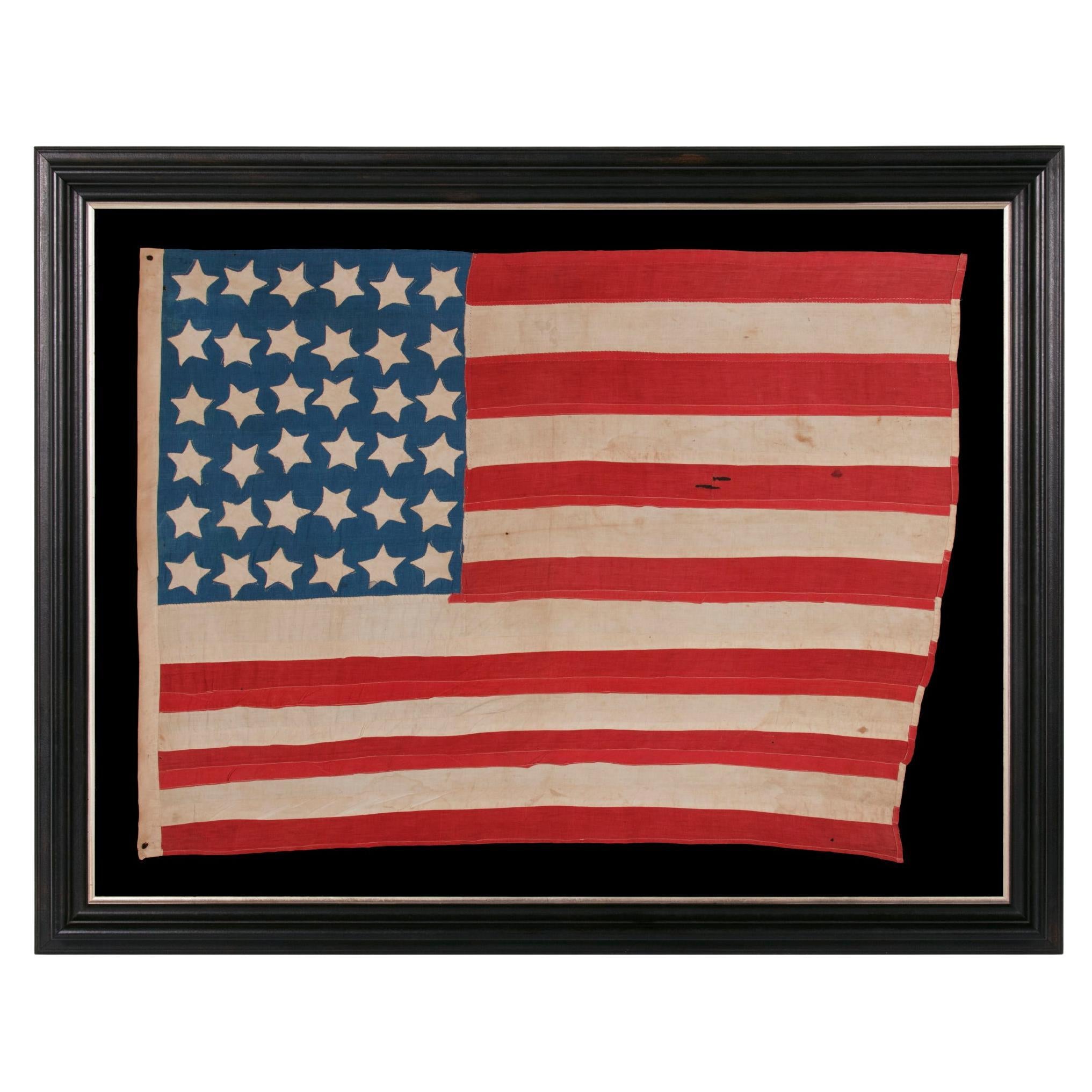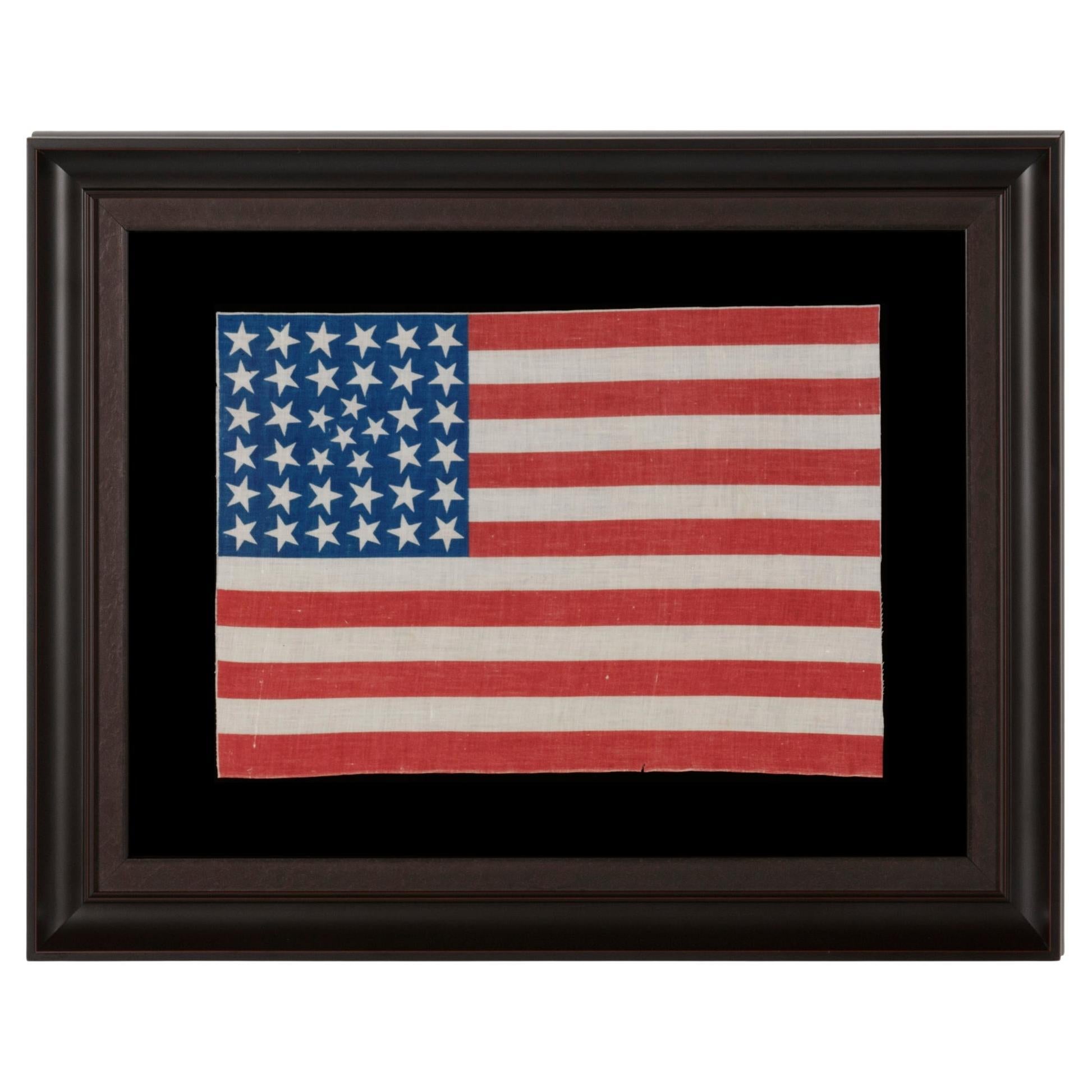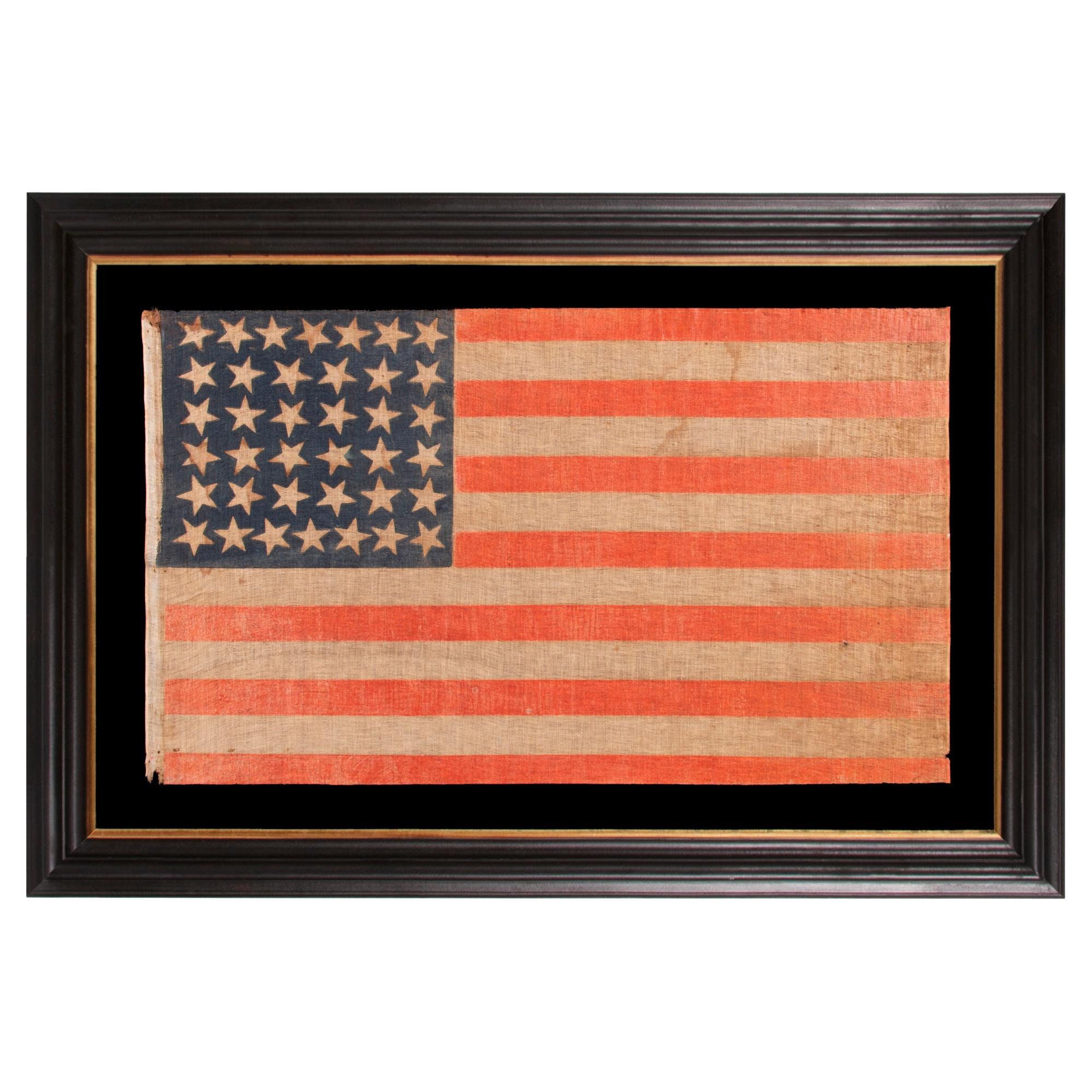Items Similar to 36 Star Antique Parade Flag, Vertical Position, Nevada Statehood, ca 1861-1867
Want more images or videos?
Request additional images or videos from the seller
1 of 6
36 Star Antique Parade Flag, Vertical Position, Nevada Statehood, ca 1861-1867
About the Item
36 STAR ANTIQUE AMERICAN PARADE FLAG, WITH STARS THAT ALTERNATE IN THEIR VERTICAL POSITION FROM COLUMN TO COLUMN AND ROW-TO-ROW, PRINTED ON AN ESPECIALLY INTERESTING LENGTH OF COARSE COTTON WITH A CRUDE WEAVE THAT RESULTS IN A VISUALLY COMPELLING APPEARANCE; CIVIL WAR ERA, NEVADA STATEHOOD, 1864-1867
36 star antique American flag, block printed on coarse, glazed cotton. The stars are arranged in justified, linear rows of 6 x 6, which, because the number laid out so logically, was typical of flags in the 36 star count. When viewed vertically, note how the stars in the first column are oriented so that each has one point directed downward, and the second displays all with one point directed upward, alternating from one column to the next, throughout the formation. If rotated to a horizontal position, note how the position of the stars in the first row are oriented so that all have one point directed in the 11:00 position, and in the next, all have one point directed at roughly 1:00, alternating back-and-forth once again, throughout, to create something I have termed "dancing rows," though it may also accurately be referred to as tilting or "canted" rows.
Perhaps the best feature, however, is the coarse cotton fabric on which the flag is printed. Instead of having warp and weft that are perpendicular to one another, there is a sweeping, serpentine pattern to the weave, the result of which is both academically and visually compelling and, though certainly unintentional, very attractive.
Lincoln pushed Nevada through to statehood on October 31st, 1864, during the Civil War, and just 8 days before the November election. The territory’s wealth in silver was attractive to a nation struggling with the debts of war and so increased support for the Republican ticket. While the 36th star wasn't officially added until July 4th of the following year, the makers of printed flags are known to have begun adding the 36th star as early as July of 1864, several months before the addition of Nevada actually occurred. This was a common practice during the late 19th century and is reflective of both the nation's desire for Westward Expansion and the hope of flag-makers to bring new star counts to market before their competitors. The 36 star flag was officially replaced by the 37 star flag in 1867, following the addition of Nebraska.
Mounting: The flag was mounted and framed within our own conservation department, which is led by expert staff. We take great care in the mounting and preservation of flags and have framed thousands of examples.
The black-painted and gilded molding dates to sometime between roughly 1920 and the 1940’s. The flag has been hand-stitched to a background of 100% cotton twill, black in color, that has been washed and treated for colorfastness. Spacers keep the textile away from the glazing, which is U.V. protective glass.
Condition: There is very minor soiling in limited areas, accompanied by minor of the same in the upper, fly end corner. There are modest to moderate stains through the first row of stars (when the flag is viewed horizontally, and dots of the same near the fly end of the 4th white stripe, and beneath the canton in the 5th white stripe, and spanning the 11th and 12th stripes, near the hoist end. The flag was at some point tacked to a wooden staff that was painted blue-green, as evidenced by small tack holes near the hoist end and minor lines of transferred pigment. Many of my clients prefer early flags to show their age and history of use.
Frame Size (H x L): 22.25" x 18.75"
Flag Size (H x L): 14.5" x 11.25"
- Dimensions:Height: 22.25 in (56.52 cm)Width: 18.75 in (47.63 cm)Depth: 2 in (5.08 cm)
- Materials and Techniques:
- Place of Origin:
- Period:
- Date of Manufacture:1861-1867
- Condition:See Item Description.
- Seller Location:York County, PA
- Reference Number:
About the Seller
5.0
Recognized Seller
These prestigious sellers are industry leaders and represent the highest echelon for item quality and design.
Established in 1991
1stDibs seller since 2008
61 sales on 1stDibs
Typical response time: 10 hours
- ShippingRetrieving quote...Ships From: York County, PA
- Return PolicyThis item cannot be returned.
More From This SellerView All
- 36 Star Antique American Parade Flag, Nevada Statehood, ca 1864-1867Located in York County, PA36 STAR ANTIQUE AMERICAN PARADE FLAG WITH CANTED STARS IN DANCING ROWS, ON A BEAUTIFUL, CORNFLOWER BLUE CANTON; CIVIL WAR ERA, NEVADA STATEHOOD, 1864-1867 36 star antique American f...Category
Antique 1860s Political and Patriotic Memorabilia
MaterialsCotton
- 34 Star Antique American Parade Flag, Kansas Statehood, ca 1861-1863Located in York County, PA34 STARS IN A MEDALLION CONFIGURATION ON AN ANTIQUE AMERICAN PARADE FLAG WITH A LARGE, HALOED CENTER STAR; CIVIL WAR PERIOD, KANSAS STATEHOOD, 1861-1863 34 star American national pa...Category
Antique 1860s American Political and Patriotic Memorabilia
MaterialsCotton
- 36 Star Antique American Parade Flag, with Canted Stars, ca 1864-1867Located in York County, PA36 STAR ANTIQUE AMERICAN PARADE FLAG WITH CANTED STARS IN DANCING ROWS, ON A BEAUTIFUL, CORNFLOWER BLUE CANTON; CIVIL WAR ERA, NEVADA STATEHOOD, 1864-1867 36 star antique American f...Category
Antique 1860s American Political and Patriotic Memorabilia
MaterialsCotton
- 36 Star Antique American Flag, Cornflower blue Canton, ca 1864-1867, NevadaLocated in York County, PAAntique American Flag With 36 Stars On A Cornflower Blue Canton, Civil War Era, 1864-1867, Reflects The Addition Of Nevada As The 36th State; A Great Folk Exaple With Haphazard Rows Of Starfish-like Stars: 36 star American national flag of the Civil War era with outstanding collector traits. Haphazard rows of fat, starfish-shaped stars fill most of the confines of a brilliant, cornflower blue canton. Note the crude piecing of the thirteen, red and white stripes, joined in an ill-planned manner that results in great variation in width, as well as general irregularity. The 4th red stripe actually falls slightly below the canton, and the height of each does not line up with the corresponding stripe on the reverse. This can clearly be seen at the fly end, which is is turned back and bound to repair obvious extended use in an outdoor environment. Clearly the maker lacked experience in seam work. Lining up the necessary components, so that they could be viewed on both sides, presented a challenge they may have not previously faced. This is also evident in the sewing of the stars, which do not line up on the obverse and reverse sides, as they typically would in a flag sewn by an experienced flag-maker. That said, this is just this kind of homemade charm that fuels interest in early American flags...Category
Antique 1860s American Political and Patriotic Memorabilia
MaterialsCotton
- 38 Star Antique American Parade Flag, Colorado Statehood, ca 1876-1889Located in York County, PA38 STARS IN AN EXTREMELY UNUSUAL CONFIGURATION THAT BEARS A CLUSTER OF 6 SMALL STARS WITHIN A LINEAL PATTERN OF LARGER STARS, 1876-1889, COLORADO STATEHOOD 38 star American national parade flag, printed on cotton. This is an extremely rare example of a lineal pattern flag with a wreath or cluster of smaller stars inserted in the center. A very small number of flags in this style are known to have survived, the colors of which are typically saturated and vibrant, like this example, in scarlet red and rich, royal blue. The particular wreath in the center of the configuration is really more of a pentagon with a single, center star. The reason for the choice of the design and 6 smaller stars seems a curious one on the surface, but its purpose was probably nothing more than to simply augment a 36 star print block to one with 38 stars. One may observe how 4 stars, that would have comprised the center of a 6 x 6 pattern, could have simply been removed and 6 smaller stars inserted in their place, in an artful fashion. At least two other similar 38-star patterns are known that incorporate 4 small stars intermingled between rows of what most certainly were two very similar 34-star flag print blocks originally. It was easier to modify these blocks rather than create brand new ones. In these particular instances, the results are rare, quirky configurations that are highly prized by collectors. Colorado became the 38th state on August 1st, 1876. This was the year of our nation’s 100-year anniversary of independence. Per the Third Flag Act of 1818, stars were not officially added until the 4th of July following a state's addition. For this reason, 37 was the official star count for the American flag in 1876. Flag-making was a competitive venture, however, and few flag-makers would have been continuing to produce 37 star flags when their competitors were making 38’s. It is for this reason that 38 and 13 stars (to represent the original 13 colonies) are more often seen at the Centennial International Exposition, the six-month long World’s Fair held in Philadelphia in honor of the event. Some flag-makers would have been adding a star for the 38th state even before it entered the Union, in the early part of 1876 or even prior. In fact, many makers of parade flags were actually producing 39 star flags, in hopeful anticipation of the addition of two more Western Territories instead of one. But the 39th state would not join the Union for another 13 years, when the Dakota Territory entered as two states on the same day. The 38 star flag became official on July 4th, 1877 and was generally used until the addition of the Dakotas in 1889. Provenance: Jeff R. Bridgman Antiques to the late collector Jim Ring...Category
Antique Late 19th Century American Political and Patriotic Memorabilia
MaterialsCotton
- 38 Star Antique American Parade Flag, Colorado Statehood, ca 1876-1889Located in York County, PA38 STAR ANTIQUE AMERICAN PARADE FLAG WITH JUSTIFIED ROWS OF 7-6-6-6-6-7 AND SCATTERED STAR ORIENTATION, MADE DURING THE PERIOD WHEN COLORADO WAS THE MOST RECENT STATE TO JOIN THE UNION, 1876-1889 38 star American national parade flag, printed on coarse cotton, possibly with flax content. One of the flag’s most interesting features is the wild sweep of the grain of the fabric, the warp and weft of which are anything but perpendicular. The stars are arranged in justified rows of 7-6-6-6-6-7. This results in a secondary pattern that I commonly call a “box-in-a-box-in-a-box”, because of the way in which the seemingly haphazard arrangement creates three consecutive squares. Note how the stars point in various directions on their vertical axis, which adds a nice element of folk quality to the overall design. Most parade flags in this star count have red stripes that lean heavily toward orange, with a vibrant, chromatic luster. This was common across printed flags produced between the 1850's and the 38 star period, phasing out in the last decade of the 19th century. Also note how the wear and patina contribute to an endearing presentation that displays its long-term use gracefully. Colorado became the 38th state on August 1st, 1876. This was the year of our nation’s 100-year anniversary of independence. Per the Third Flag Act of 1818, stars were not officially added until the 4th of July following a state's addition. For this reason, 37 was the official star count for the American flag in 1876. In the latter 19th century, it became common to add stars before the respective state(s) had even entered the Union. No one cared what was official, not even the military, where the matter of practicality with regard to flags always seems to have outweighed regulations. In the private sector, commercial flag-making was a competitive venture. Few flag-makers continued to produce 37 star flags when their competitors had jumped the star count to 38. It is for this reason that 38 and 13 stars (to represent the original 13 colonies) are more often seen at the Centennial International Exposition, the six-month long World’s Fair, held in Philadelphia, that served as the nucleus of the national celebration. Some makers of printed parade flags actually began to produce 39 star flags in 1876, in hopeful anticipation of the addition of two more Western Territories instead of one. The 39th state would not join the Union for another 13 years, however, when the Dakota Territory—thought to be coming as a single state—entered as two separate states on November 2nd, 1889. The 38 star flag generally fell out of production at that time, though it technically remained official until July 3rd, 1890. President Ulysses S. Grant was in office when the first 38 star flags would have appeared. The list of presidents that served during the period when the 38 star flag was official include Rutherford B. Hayes, James Garfield...Category
Antique Late 19th Century American Political and Patriotic Memorabilia
MaterialsCotton
You May Also Like
- 34-Star Civil War American Flag, Antique Great Star Pattern, circa 1861Located in Colorado Springs, COThe stars of this extremely rare, Civil War-era flag are arranged in what is sometimes called the "Great Flower" pattern, a large star made out of smaller stars -- named as such beca...Category
Antique 1860s American Political and Patriotic Memorabilia
MaterialsLinen
- 31-Star Printed American Flag, Celebrating California Statehood, Circa 1850Located in Colorado Springs, COThis is a rare 31-star medallion printed American flag, celebrating the addition of California to the Union. The flag is printed on silk and has a spectacular “Great Star” canton pat...Category
Antique 1850s American Political and Patriotic Memorabilia
MaterialsSilk
- 1889 North Dakota 39 Star United States of America Statehood FlagLocated in Coeur d'Alene, ID39 star silk statehood flag. 23 1/2" x 15". Was the unofficial North Dakota Flag. As South Dakota was also admitted as the 40th state on the same day this...Category
Antique 1880s American Historical Memorabilia
MaterialsSilk
- Original Painted Metal Parade FlagLocated in Los Angeles, CAThis fun and folky 20thc original painted parade flag sign was used to hand in the windows during patriotic events. In stores and homes in the early 20thc.Category
Antique Late 19th Century American Adirondack Political and Patriotic Me...
MaterialsTin
- 36-Star Printed American Flag, Rare Haloed Star Medallion, Circa 1865Located in Colorado Springs, COThis 36-star flag has stars arranged in a gorgeous and highly desirable medallion pattern. This particular medallion includes a large haloed star in the middle, two rings of stars s...Category
Antique 1860s American Political and Patriotic Memorabilia
MaterialsFabric
- 39-Star Antique American Flag with 'Whimsical' Star Pattern, 1889Located in Colorado Springs, COThis is a 39-star unofficial American flag, handmade and printed on cotton. The flag dates to 1889 and has a unique history, thanks to its rare star-count. The flag’s canton is prin...Category
Antique 1880s American Political and Patriotic Memorabilia
MaterialsCotton
Recently Viewed
View AllMore Ways To Browse
Modern Pennants
Flag Pole With Eagle
Korean Flag
Folk Art American Eagle
Antique American Flag 49 Stars
Chinese Porcelain Lunch Box
Pennant Banner
Prints Men In Confederate Uniform
Star Wars Prop
Hermes Scarf Folk
Toy Sewing Machine
Uss Utah
A Moderate Gale
Antique Jewelry Lancaster Pa
Grand Duchess Tatiana
Rosenthal Iwo Jima
Toy Singer Sewing Machine
Buermann Spurs

